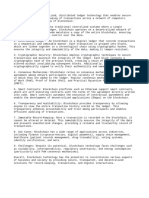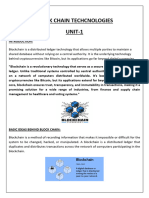0% found this document useful (0 votes)
11 views1 pageLecture Notes: Introduction To Blockchain Technology
Blockchain is a decentralized ledger technology that records transactions securely and transparently across multiple computers. Key features include decentralization, immutability, consensus mechanisms, and smart contracts, which enable automated transactions. While it underpins cryptocurrencies, blockchain has broader applications and faces challenges such as scalability and regulatory uncertainty.
Uploaded by
dilhanmacysCopyright
© © All Rights Reserved
We take content rights seriously. If you suspect this is your content, claim it here.
Available Formats
Download as DOCX, PDF, TXT or read online on Scribd
0% found this document useful (0 votes)
11 views1 pageLecture Notes: Introduction To Blockchain Technology
Blockchain is a decentralized ledger technology that records transactions securely and transparently across multiple computers. Key features include decentralization, immutability, consensus mechanisms, and smart contracts, which enable automated transactions. While it underpins cryptocurrencies, blockchain has broader applications and faces challenges such as scalability and regulatory uncertainty.
Uploaded by
dilhanmacysCopyright
© © All Rights Reserved
We take content rights seriously. If you suspect this is your content, claim it here.
Available Formats
Download as DOCX, PDF, TXT or read online on Scribd
/ 1



































































